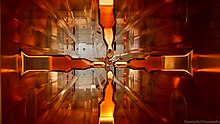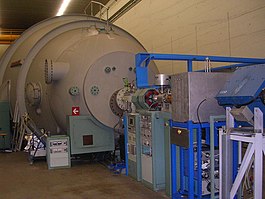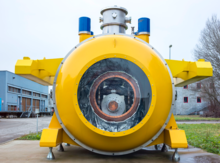
Fermi National Accelerator Laboratory (Fermilab), located in Batavia, Illinois, near Chicago, is a United States Department of Energy national laboratory specializing in high-energy particle physics.

TRIUMF is Canada's national particle accelerator centre. It is considered Canada's premier physics laboratory, and consistently regarded as one of the world's leading subatomic physics research centres. Owned and operated by a consortium of universities, it is on the south campus of one of its founding members, the University of British Columbia in Vancouver, British Columbia, Canada. It houses the world's largest normal conducting cyclotron, a source of 520 MeV protons, which was named an IEEE Milestone in 2010. Its accelerator-focused activities involve particle physics, nuclear physics, nuclear medicine, materials science, and detector and accelerator development.

Accelerator mass spectrometry (AMS) is a form of mass spectrometry that accelerates ions to extraordinarily high kinetic energies before mass analysis. The special strength of AMS among the different methods of mass spectrometry is its ability to separate a rare isotope from an abundant neighboring mass. The method suppresses molecular isobars completely and in many cases can also separate atomic isobars. This makes possible the detection of naturally occurring, long-lived radio-isotopes such as 10Be, 36Cl, 26Al and 14C.

The ISOLDE Radioactive Ion Beam Facility, is an on-line isotope separator facility located at the centre of the CERN accelerator complex on the Franco-Swiss border. Created in 1964, the ISOLDE facility started delivering radioactive ion beams (RIBs) to users in 1967. Originally located at the Synchro-Cyclotron (SC) accelerator, the facility has been upgraded several times most notably in 1992 when the whole facility was moved to be connected to CERN's ProtonSynchroton Booster (PSB). ISOLDE is currently the longest-running facility in operation at CERN, with continuous developments of the facility and its experiments keeping ISOLDE at the forefront of science with RIBs. ISOLDE benefits a wide range of physics communities with applications covering nuclear, atomic, molecular and solid-state physics, but also biophysics and astrophysics, as well as high-precision experiments looking for physics beyond the Standard Model. The facility is operated by the ISOLDE Collaboration, comprising CERN and sixteen (mostly) European countries. As of 2019, close to 1,000 experimentalists around the world are coming to ISOLDE to perform typically 50 different experiments per year.

The Argonne Tandem Linac Accelerator System (ATLAS) is a U.S. Department of Energy scientific user facility at Argonne National Laboratory. ATLAS is the first superconducting linear accelerator for heavy ions at energies in the vicinity of the Coulomb barrier and is open to scientists from all over the world.

The Variable Energy Cyclotron Centre (VECC) is a research and development unit of the Department of Atomic Energy. The VECC is located in Kolkata, India and performs research in basic and applied nuclear sciences and development of the latest nuclear particle accelerators. It has a collaboration with the European Organization for Nuclear Research. The Centre houses a 224 cm cyclotron—the first of its kind in India—which has been operational since 16 June 1977. It provides proton, deuteron, alpha particle and heavy ion beams of various energies to other institutions.

Laboratori Nazionali del Gran Sasso (LNGS) is the largest underground research center in the world. Situated below Gran Sasso mountain in Italy, it is well known for particle physics research by the INFN. In addition to a surface portion of the laboratory, there are extensive underground facilities beneath the mountain. The nearest towns are L'Aquila and Teramo. The facility is located about 120 km from Rome.
The High Luminosity Large Hadron Collider is an upgrade to the Large Hadron Collider, operated by the European Organization for Nuclear Research (CERN), located at the French-Swiss border near Geneva. From 2011 to 2020, the project was led by Lucio Rossi. In 2020, the lead role was taken up by Oliver Brüning.

The Istituto Nazionale di Fisica Nucleare is the coordinating institution for nuclear, particle, theoretical and astroparticle physics in Italy.
Astroparticle physics, also called particle astrophysics, is a branch of particle physics that studies elementary particles of astrophysical origin and their relation to astrophysics and cosmology. It is a relatively new field of research emerging at the intersection of particle physics, astronomy, astrophysics, detector physics, relativity, solid state physics, and cosmology. Partly motivated by the discovery of neutrino oscillation, the field has undergone rapid development, both theoretically and experimentally, since the early 2000s.

Nigel Stuart Lockyer is a British-American experimental particle physicist. He is the current director of the Cornell Laboratory for Accelerator-based ScienceS and Education (CLASSE) as of May 1, 2023. He was the Director of the Fermi National Accelerator Laboratory (Fermilab), in Batavia, Illinois, the leading particle physics laboratory in the United States, from September 2013 to April 2022.
The Triangle Universities Nuclear Laboratory, abbreviated as TUNL, is a tripartite research consortium operated by Duke University, the University of North Carolina at Chapel Hill, North Carolina State University and North Carolina Central University. The laboratory is located on the West Campus of Duke University in Durham, North Carolina. Researchers are now drawn from several other universities around the United States in addition to members from the founding universities. TUNL also participates in long term collaborations with universities and laboratories around the world. Funding for TUNL comes primarily from the United States Department of Energy Office of Nuclear Physics.

FAZIA stands for the Four Pi A and Z Identification Array.
ADA was one of the first Italian particle accelerators and the first-ever electron–positron particle collider, measuring approximately 1.3 metres in diameter and designed to store beams of 250 MeV.
The DarkSide collaboration is an international affiliation of universities and labs seeking to directly detect dark matter in the form of weakly interacting massive particles (WIMPs). The collaboration is planning, building and operating a series of liquid argon time projection chambers (TPCs) that are employed at the Gran Sasso National Laboratory in Assergi, Italy. The detectors are filled with liquid argon from underground sources in order to exclude the radioactive isotope 39
Ar, which makes up one in every 1015 (quadrillion) atoms in atmospheric argon. The Darkside-10 (DS-10) prototype was tested in 2012, and the Darkside-50 (DS-50) experiment has been operating since 2013. Darkside-20k (DS-20k) with 20 tonnes of liquid argon is being planned as of 2019.
AURIGA is an ultracryogenic resonant bar gravitational wave detector in Italy. It is at the Laboratori Nazionali di Legnaro of the Istituto Nazionale di Fisica Nucleare, near Padova. It is being used for research into gravitational waves and quantum gravity.

The Radioactive Isotope Beam Factory is a multistage particle accelerator complex operated by Japan's Nishina Center for Accelerator-Based Science which is itself a part of the Institute of Physical and Chemical Research. Located in Saitama, the RIBF generates unstable nuclei of all elements up to uranium and studies their properties. According to physicist Robert Janssens, "[it] can produce the most intense beams of primary particles in the world."

RAON is a South Korean particle physics laboratory within the Rare Isotope Science Project (RISP) that is being constructed in the outskirts of Daejeon neighboring Sejong, South Korea by the Institute for Basic Science (IBS). It was expected to be finished by 2021 before getting pushed back to 2025.

The ISOLDE Solenoidal Spectrometer (ISS) experiment is a permanent experimental setup located in the ISOLDE facility at CERN. By using an ex-MRI magnet, heavy radioactive ion beams (RIBs) produced by the HIE-ISOLDE post-accelerator are directed at a light target and the kinematics of the reaction is measured. The purpose of the experiment is to measure properties of atomic nuclei replicating the conditions present in some astrophysical processes, such as the production of chemical elements in stars. The experiment will also produce results that provide a better understanding of nucleon-nucleon interactions in highly-unstable, very radioactive (exotic) nuclei.

Ilan Ben-Zvi is an accelerator physicist and academic. He was the associate chair for accelerator R&D at the Collider-Accelerator Department (C-AD), and is a distinguished scientist emeritus at the Collider-Accelerator Department (C-AD) at Brookhaven National Laboratory.


















